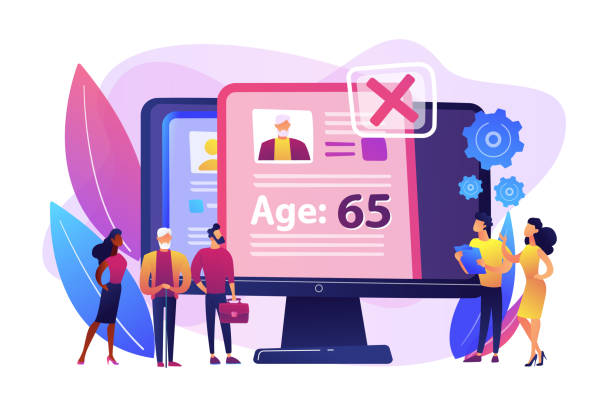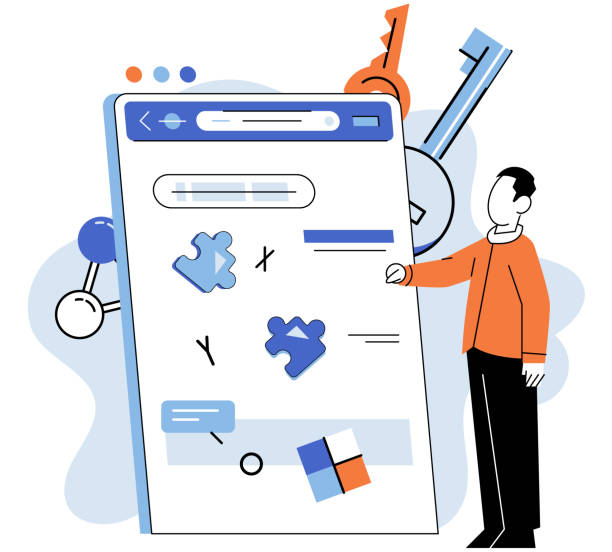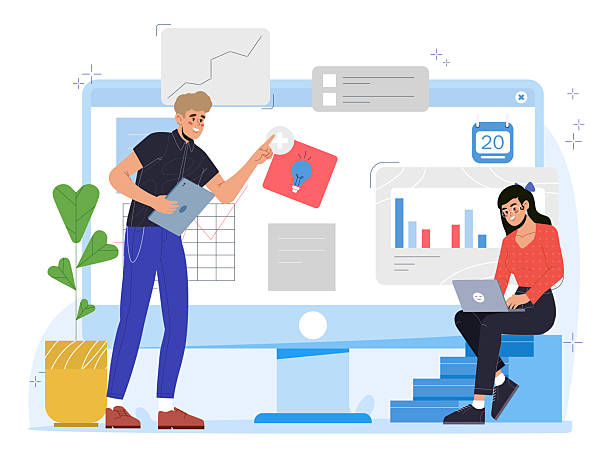The Unrivaled Importance of Fast Website Design in Today’s World

In the current digital age, speed is paramount.
#Website_speed not only has a direct impact on #User_experience, but it is also a vital factor in #SEO_ranking and increasing #Conversion_rate.
A slow website can drive visitors away and damage your business’s credibility.
For this reason, fast website design is more than an advantage; it’s a necessity.
This includes technical, infrastructural, and content optimizations, all working hand-in-hand to provide a smooth and pleasant user experience.
High-speed websites not only keep users satisfied but also send positive signals to search engines, leading to greater visibility in search results.
Today, users expect websites to load instantly.
Any delay, even a few milliseconds, can mean losing potential customers.
This is of double importance for online businesses that are highly dependent on traffic and user interaction.
Investing in fast website design means investing in the future of your business.
This will not only lead to increased customer satisfaction but also higher returns on your digital marketing campaigns.
The faster a site is, the more likely users are to stay longer, view more pages, and ultimately reach your final goal (e.g., purchasing a product or signing up).
This is a simple but powerful principle in web optimization.
Are your e-commerce website visitors leaving before making a purchase? Don’t worry anymore! With Rasaweb’s professional e-commerce website design services, permanently solve the problem of converting visitors into customers!
✅ Significant increase in conversion rate and sales
✅ Unique and engaging user experience
⚡ Contact us now for a free consultation!
Technical Factors Affecting Website Loading Speed

To achieve fast website design, understanding technical factors is crucial.
One of the most important factors is hosting quality.
Choosing strong and optimized hosting, with high-speed servers and sufficient bandwidth, forms the foundation of a fast website.
Cheap shared hosting may seem attractive at first, but they usually have limited resources that can lead to slow website performance.
Furthermore, code optimization, including compressing CSS, JavaScript, and HTML files, removing unnecessary code, and using optimal loading techniques (such as asynchronous loading), plays a significant role.
This is a specialized topic that requires programming and webmaster knowledge.
Image optimization is also a vital part; large images can severely reduce loading speed.
Using next-generation image formats (like WebP), compressing images without losing quality, and lazy loading images all contribute to speed improvement.
Using a Content Delivery Network (CDN) is also an effective solution for websites with a global audience.
A CDN caches your site’s content on multiple servers worldwide, delivering content from the closest server to the user and significantly reducing loading time.
This is a comprehensive explanation of the technical aspects of fast website design that every developer should pay attention to.
Modern Tools and Techniques for Speed Optimization

In the pursuit of fast website design, utilizing up-to-date tools and techniques is of paramount importance.
Tools such as Google PageSpeed Insights, GTmetrix, and Lighthouse offer deep analytical capabilities that help identify website speed bottlenecks.
These tools provide suggestions for improvement by scoring your site’s performance on desktop and mobile, including items like GZIP compression, eliminating render-blocking resources, reducing server response time, and optimizing CSS and JavaScript.
Using caching systems is also one of the most effective ways to increase speed.
Caching allows browsers and servers to store copies of your website’s static content, so there’s no need for a full reload on subsequent visits.
This is particularly beneficial for high-traffic websites.
Implementing both server-side and client-side caching is essential for achieving the highest level of performance.
Alongside these, choosing the right platform is also crucial; Content Management Systems (CMS) like WordPress, with numerous speed optimization plugins, can assist you in this journey.
This section is designed as a practical guide and educational resource for anyone looking for fast website design.
| Tool | Main Use | Key Benefits |
|---|---|---|
| Google PageSpeed Insights | Evaluate speed on mobile and desktop, provide Google recommendations | Integration with Core Web Vitals and Google ranking factors, free |
| GTmetrix | Comprehensive analysis of site performance with high detail | Detailed reports, performance comparison, loading video |
| Lighthouse (Chrome DevTools) | Auditing performance, accessibility, best practices, and SEO | Built-in Chrome browser tool, multi-faceted reports |
| Pingdom Tools | Speed testing from various locations worldwide, uptime monitoring | Support for periodic tests, simple user interface |
The Impact of Speed on User Experience and Conversion Rate

A website’s speed is not just a technical factor, but an important analytical factor in User Experience (UX) and Conversion Rate.
Today’s users are impatient, and if a site doesn’t load quickly, they will easily leave it and go to your competitors.
This means losing visitors, potential customers, and ultimately, revenue.
Studies have shown that even small delays in page loading can have significant impacts on bounce rate and conversion rate.
Therefore, fast website design is directly tied to your business’s commercial success.
Websites that are fast convey a sense of trust and professionalism.
When a user encounters a slow site, it creates the impression that the business in question doesn’t care about details or is technically weak.
These negative perceptions can damage your brand’s credibility.
In contrast, a fast site not only makes operations smoother but also gives the user a sense of control and efficiency.
These positive feelings are more likely to lead to increased engagement, longer site visits, and ultimately, desired actions such as purchases, registrations, or contacts.
This is a complete explanation of why speed matters in the real world and its impact on user psychology and business goals.
The importance of fast website design can be examined from various perspectives, none of which should ever be ignored.
Are you tired of your e-commerce site having visitors but no sales? Rasaweb, with professional e-commerce website design, solves your main problem!
✅ Significant increase in sales with targeted design
✅ Flawless user experience for your customers
⚡ Get a free consultation!
Mobile-First Approach and its Role in Website Speed

With the significant increase in mobile device usage for internet access, the Mobile-First approach (Mobile-First) has become a fundamental principle in fast website design.
Search engines like Google primarily consider your site’s mobile version for indexing and ranking.
Therefore, if your site is slow on mobile, not only will you have a poor user experience, but your SEO ranking will also be affected.
Optimization for mobile includes using Responsive Design, optimizing images and videos for smaller screens and slower networks, and ensuring all interactive elements function correctly on touch devices.
In the mobile-first approach, the site is designed and developed for mobile devices first, and then extended to desktop versions.
This method ensures that your site performs optimally even under the weakest network conditions and on the smallest screens.
Optimizing codes and resources for mobile, reducing HTTP requests, and using optimized formats for mobile all significantly contribute to loading speed.
This is a specialized discussion that requires particular attention from developers.
Disregarding mobile speed can become a questionable content in your digital strategy and lead to the loss of a large portion of your audience.
Therefore, if you are looking for fast and successful website design, never forget the mobile-first approach.
Common Mistakes in Web Design and Solutions to Avoid Them

In the process of fast website design, some common mistakes can render your efforts fruitless.
One such mistake is loading multiple and large fonts, which can significantly increase initial page load time.
The guidance here is to limit the number of fonts and use optimized web fonts (such as WOFF2).
Another mistake is the excessive use of add-ons and plugins in CMSs, each of which might add extra code and numerous HTTP requests to the site, reducing speed.
Lacking GZIP or Brotli compression for CSS, JS, and HTML files is also a common error.
These compressions can reduce file sizes by up to 70% and have a significant impact on loading speed.
Furthermore, not optimizing images in terms of size and format slows down websites.
Using very high-resolution images for regular displays, is a primary source of slowness.
The questionable content in this regard is whether we truly need all these graphical details and codes? Often, the answer is no.
Database optimization, cleaning up old and unnecessary data, and improving queries also significantly contribute to increasing site speed.
Avoiding these mistakes and adhering to best practices will help you achieve a fast and efficient website design.
Continuous Monitoring and Analysis of Website Performance

Fast website design is not a one-time process; it requires continuous analytical monitoring and analysis.
Website performance may fluctuate over time due to content changes, increased traffic, or software updates.
Using website performance monitoring (APM) tools and speed analysis tools such as Google Search Console, GTmetrix, or Pingdom Tools allows you to regularly check your site’s performance.
These tools provide detailed news and statistical reports on loading time, Core Web Vitals, and other Key Performance Indicators (KPIs).
Continuous monitoring helps you quickly identify performance issues and resolve them before they negatively impact user experience.
Furthermore, this process helps you evaluate the effect of new changes on site speed.
For example, after adding a new plugin or updating the site’s theme, you should recheck performance to ensure it has not negatively affected speed.
The guidance in this area is to have a regular schedule for testing your site’s speed and compare the results to understand trends.
This proactive and educational approach ensures that your site always remains in its best operational state and adheres to fast and optimized website design.
| Factor (Metric) | Description | Importance in User Experience |
|---|---|---|
| LCP (Largest Contentful Paint) | Time to load the largest visible content element in the Viewport | User’s perception of the main content loading speed |
| FID (First Input Delay) | Time from the user’s first interaction until the browser responds to it | Site responsiveness to initial user interactions |
| CLS (Cumulative Layout Shift) | Amount of unexpected visual element movement during page loading | Visual stability of the page, preventing unintended clicks |
| FCP (First Contentful Paint) | Time of the first display of content (text, images) on the page | Indicates that content is loading |
Optimizing Images and Media for Higher Speed

Images and media are among the biggest factors affecting website loading speed.
Many websites upload images raw, without considering their size and format, which can severely harm fast website design.
The most specialized guidance in this area is to use appropriate image formats.
Next-generation formats like WebP can deliver high-quality images with significantly smaller file sizes.
Compared to JPEG and PNG, WebP is largely effective in reducing file sizes.
Additionally, using image compression tools such as TinyPNG or Compressor.io is essential to reduce image size without a noticeable loss in quality.
Besides compression, using responsive features in HTML (like `srcset` and `sizes`) to deliver different image sizes based on the user’s device is very important.
This ensures that the browser only downloads an image that is appropriate for the user’s screen size, rather than a large, heavy image.
Furthermore, implementing lazy loading (Lazy Loading) for images and videos, which means loading visual content only when it enters the user’s Viewport, can significantly impact initial page load speed.
This is a comprehensive explanation of how to optimize media, which not only increases speed but also saves bandwidth.
Optimizing images and media is an integral part of any fast website design strategy.
Are you tired of your e-commerce site having visitors but no sales? Rasaweb, with professional e-commerce website design, solves your main problem!
✅ Significant increase in sales with targeted design
✅ Flawless user experience for your customers
⚡ Get a free consultation!
The Future of Web Design and the Role of Speed in It

With technological advancements and increasing user expectations, the future of web design is moving towards greater speed and efficiency.
The emergence of technologies such as PWA (Progressive Web Apps) and AMP (Accelerated Mobile Pages) indicates a focus on immediate and uninterrupted user experience.
PWAs bring native app-like capabilities to websites, including offline functionality and faster loading, all of which contribute to fast website design.
AMP is also designed to deliver web content on mobile with exceptional speed.
This analytical trend indicates that speed will soon be a mandatory standard, not just a desirable feature.
The questionable content here is whether traditional websites without these optimizations will be able to compete? The answer is likely no.
Furthermore, Artificial Intelligence and Machine Learning will also play an increasing role in optimizing site performance.
From predicting user behavior for smart caching to automatically identifying performance bottlenecks, AI can revolutionize the fast website design process.
Investing in new technologies and keeping pace with changes not only improves user experience but also provides a significant competitive advantage.
These developments offer exciting and thrilling opportunities for developers and businesses to create super-fast and responsive websites.
Final Conclusion: Speed, The Key to Success on the Web

In conclusion, it can be said that fast website design is no longer a luxury option, but a vital necessity for any business that wants to succeed in the online space.
Website speed not only directly affects user satisfaction and experience but is also an important factor in search engine rankings, and consequently, visibility and attracting new customers.
From technical optimization of codes and images to choosing suitable hosting and using analytical tools, every step taken towards increasing site speed will contribute to your greater success.
Given the increasing growth of mobile usage and high user expectations, investing in fast website design and continuous performance optimization is a strategic and long-term decision.
By adhering to the principles and techniques discussed in this article, you can ensure that your website not only loads quickly but also provides a positive user experience that will lead to increased engagement, conversion rates, and ultimately, the growth of your business.
Remember that in today’s competitive world, speed can make the difference between success and failure.
Frequently Asked Questions
| Question | Answer |
|---|---|
| What is fast website design? | A process for building a website that loads quickly and provides a smooth and optimized user experience. |
| Why is website speed important? | Increases user satisfaction, improves search engine ranking (SEO), reduces bounce rate, and increases conversion rate. |
| What factors affect website speed? | Page size, number of HTTP requests, image optimization, JavaScript and CSS codes, server speed, and use of caching. |
| How can website speed be measured? | Using tools like Google PageSpeed Insights, GTmetrix, Pingdom Tools. |
| How can website speed be increased? | Optimizing images, compressing files (CSS, JS, HTML), browser caching, reducing redirects, choosing suitable hosting. |
| Does fast website design mean low quality? | No, fast design means designing with a focus on speed and efficiency optimization, not reducing the quality of design or content. |
| What is the role of hosting in website speed? | The speed and quality of the hosting server directly affect the site’s response time and consequently the loading speed. |
| How can images be optimized for speed? | Using appropriate formats (like WebP), compressing images without significant quality loss, specifying definite dimensions for images. |
| Can complex websites also be fast? | Yes, by using appropriate architecture, code optimization, and resource management, even complex websites can have high speed. |
| Is fast website design the same as Agile development? | No, fast website design focuses on the final outcome (a fast website), while Agile development is a methodology for project management and software development. |
And other services of Rasa Web Advertising Agency in the field of advertising
Smart Direct Marketing: A combination of creativity and technology for campaign management through custom programming.
Smart Digital Advertising: An innovative platform for improving click-through rates with precise audience targeting.
Smart Content Strategy: A combination of creativity and technology to increase website traffic through Google Ads management.
Smart Sales Automation: Professional optimization to increase sales using SEO-driven content strategy.
Smart Brand Identity: Designed for businesses seeking to increase sales through attractive UI design.
And over a hundred other services in the field of internet advertising, advertising consultation, and organizational solutions
Internet Advertising | Advertising Strategy | Advertorial
Sources
10 Tips for Increasing Website SpeedPrinciples of Fast and User-Friendly Website DesignComprehensive Guide to Website Performance OptimizationWhy Website Speed is Important for SEO?
? With Rasaweb Afarin, a specialist in comprehensive digital marketing services and personal website design, transform your business and have a powerful online presence.
📍 Tehran, Mirdamad Street, next to Bank Markazi, Southern Kazeroon Alley, Ramin Alley, No. 6



